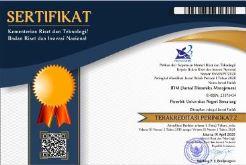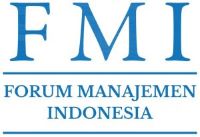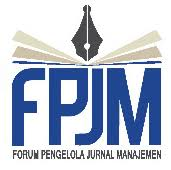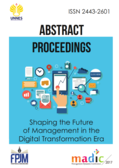Organizational Effectiveness: Social Capital and Competitive Advantage Approach
Abstract
This study is aimed at developing the model of organizational effectiveness in university through social capital and competitive advantage. The populations of this study are the head of study programs and the structural officials in some Universities in Semarang. In this case, We used Structural Equation Modeling (SEM) in AMOS 21.0 program as the analysis tool. The result of the study and model analysis showed that even though the social capital had significant positive influenced to the competitive advantage in the university, the improvement of social capital and competitive advantage at university could not improve the university organizational effectiveness. Then, between two factors which influenced the competitive advantage (internal social capital and external social capital), it is obtained that external social capital got the dominant influenced factor to competitive advantage. The managerial implication suggested the policies should focus on improving the quality of cooperative relationships with external parties in the university.
Tujuan dari penelitian ini adalah membangun model efektifitas organisasi pada perguruan tinggi melalui modal sosial dan keunggulan bersaing. Populasi dalam penelitian ini adalah ketua program studi maupun pejabat struktural pada perguruan tinggi di Semarang. Alat analisis data yang digunakan adalah Structural Equation Modelling (SEM) pada program AMOS 21.0.Hasil pengujian dan analisis model menunjukkan bahwa pada meskipun modal sosial memiliki pengaruh positif signifikan terhadap keunggulan berasingn pada perguruan tinggi namun peningkatan modal sosial dan keunggulan kompetitif pada perguruan tinggi belum mampu meningkatkan efektifitas organidsasi perguruan tinggi tersebut. Selanjutnya diantara kedua faktor yang mempengaruhi keunggulan bersaing (internal social capitaldan external social capital), didapatkan bahwa external social capital merupakan faktor yang paling dominan pengaruhnya terhadap keunggulan bersaing. Implikasi manajerial yang dapat disarankan oleh penelitian ini adalah kebijakan yang menitikberatkan pada peningkatan kulitas hubungan kerjasama dengan pihak eksternal pada perguruan tinggi.
JEL Classification: L, L2, L20
Keywords
Full Text:
PDFReferences
Adler, P & Kwon, S. 2002. Social Capital: Prospects for a New Concept.Academy of Management Review. 27(1): 17-40.
Aaker, D. A. 1989. Managing Capitals and Skills: The Key to a Sustainable Competitive Advantage. California Management Review. 31(Winter): 91-106.
Aaker, D. A. 1998. Strategic Market management. Edisi ke-5. New York: John Wiley.
Amit, R & Schoemaker, P. 1993. Strategic Assets and Organizational Rent. Strategic Management Journal. 14(1): 33-46
Aprilia, K & Ghozali, I. 2013. Teknik Penyusunan Skala Likert dalam Penelitian Akuntansi dan Bisnis. Semarang: Fatawa Publishing.
Barney, J. B. 1991. Firm Resources and Sustained Competitive Advantage. Journal of Management. 17(1): 99 - 120.
Barney, J. B.1995. Looking Inside for Competitive Advantage.Academy of Management Review. 19(4): 49-61.
Berzina, K. 2011. Enterprise Related Social Capital: Different Levels of Social Capital Accumulation. Economics & Sociology. 4(2). 66-83.
Beugelsdijk, S., Noorderhaven, N. G & Koen, C.I.2005. Organizational Culture, Alliance, Capabilities and Social Capital In T.Gossling, R.J.G. & Jansen Oerlemans (eds). Nijmegen: Wolf Publishers.
Bharadwaj, S. G., Varadarajan, P. R& Fahy, J. 1993.Sustainable Competitive Advantage in Service Industries: A Conceptual Model and Research Propositions.Journal of Marketing. 57(October): 83-100.
Bryk, A.S & Schneider, B. 2002. Trust in Schools: A Core Resource for Improvement. New York: Sage
Burt, R. 1992. Structural Holes: The Social Structure of Competition. Cambridge, MA: Harvard University Press,
Burt, R. 1997. The Contingent Value of Social Capital. Administrative Science Quarterly. 42 (2): 339–365.
Burt, R. 2000.The Network Structure of Social Capital. Organizational Behaviour, Vol (22). New York: JAI Press.
Cameron, K. S. 1978. Measuring Organizational Effectiveness In Institutions of Higher Education. Administrative Science Quarterly. 23: 604–632.
Cameron, K. S. 1981. Critical Question in Assessing Organizational Effectiveness. Organizational Dynamic. 9: 66-80.
Cappelli, P&Sherer, P. 1991. The Missing Role of Context in OB: The Need for a Meso-Level Approach. ResearchinOrganizational Behavior. 13: 55–110.
Casanueva, C& Gallego, Á. 2010. Social Capital and Individual Innovativeness in University Research Networks. Innovation: Management, Policy & Practice. 12(1): 105-117.
Coleman, J. 1988. Social Capital in the Creation of Human Capital. American Journal of Sociology. 94 (Supplement): 95-120.
Coleman, J. 1990. Foundations of Social Theory. Cambridge, MA: Harvard University Press.
Collins, C. J&Clark, K. D. 2003. Strategic Human Resources Practices and Top Management Team Social Networks. Academic Management Journal. 46(6): 740–752.
Conner, K. R. 1991. A Historical Comparison of Resource-Based Theory and Five Schools of Thought Within Industrial Organization Economics: Do We Have a New Theory of the Firm. Journal of Management, 17(1): 121-154
Cravens, Davis W.1996. Pemasaran Strategis (Terjemahan). Jakarta: Penerbit Erlangga.
Day, George & Robin Wensley, 1988. Assessi Advantage: A Framework for Dianostic Competitive Superity. Journal of Marketing. 52: 1-20.
Fauzan, M. 2012. Peningkatan Kinerja Dosen Berbasis Modal Sosial Dan Dukungan Organisasional di PTS kota semarang. Jurnal Bisnis dan Ekonomi. 19 (2): 188-202.
Ferdinand, A. 1999. Strategic Pathways towards Sustainable Competitive Advantage. UnpublishedDBA Thesis. Australia: Southern Cross University,
Ferdinand, A. 2005. Modal Sosial Dan Keunggulan Bersaing: Wajah Sosial Strategi Pemasaran. Semarang: Badan Penerbit Universitas Diponegoro.
Ferdinand, A. 2013. Metode Penelitian Manajemen. Semarang: Undip Press.
Geletkanycz, M&Hambrick, D. 1997. The external ties of top executives: Implications for strategic choice and performance. Administrative Science Quarterly. 42: 654-681.
Ghozali, I. 2013. Model Persamaan Struktural (Konsep dan Aplikasi dengan Program AMOS 21.0). Semarang: Badan Penerbit Universitas Diponegoro.
Goldring, E. 1995. Striking a Balance: Boundary Spanning and Environmental Management in Schools. S. Bacharach, B. Mundell, eds. Images of Schools, Structures and Roles in Organizational Behavior. Corwin Press, Thousand Oaks. CA: 293–314.
Hair, J. R., Rolph, J. F., Anderson, E., Tatham, R. L & Black, W. C. 2010. Multivariate Data Analysis with Readings. Fourth Edition. New York: Prentice Hall International.
Hall, R. 1994. A Framework for Identifying the Intangible Sources of Sustainable Competitive Advantage, In G. Hamel & A. Heene (Eds.), Competence-Based Competition, pp. 149-169, Baffins Lane, Chichester. England: John Willey & Sons Ltd.
Harmancioglu, N., Grinstein, A & Goldman, A.2010. Innovation and Performance Outcomes of Market Information Collection Efforts: The Role of Top Management Team Involvement. International journal of Research in Marketin. 27 (1): 33–43.
Hargreaves, D. 2003. Education Epidemic: Transforming Secondary Schools through Innovation Networks. London, UK: Demos.
Hart, S. L& Banbury, C.1994. How Strategy-Making Processes Can Make a Difference. Strategic Management Journal. 15: 251-269.
Hearn, G., Close, A., Smith, B& Southey, G. 1996.Defining Generic Professional Competencies in Australia: Towards a Framework for Professional Development.Asia Pacific Journal of Human Resources. 34(1): 44 - 62.
Heath, C&Sitkin, S. 2001. Big-B versus Big-O: What is Organizational About Organizational Behavior? Journalof OrganizationalBehavior. 22: 43-58.
Johns, G. 2001. In praise of context. Journalof OrganizationalBehavior. 22: 31-42.
Kale, P., Singh,H&Perlmutter, H. 2000. Learning and Protection of Proprietary Assets in Strategic Alliances: Building relational capital. Strategic Management Journal. 21 (2): 17–237.
Leana, C. R & Van Buren. H. 1999. Organizational Social Capital and Employment Practices. Academic Management Review. 24(3): 538-555.
Leana, C. R&Pil, F. K.2006. Social Capital and Organizational Performance: Evidence from Urban Public Schools. Organization Science.17 (3): 353-366.
Lewrick, M., Robert, R &Thomas, P. 2007. A Cross-Sector Exploration on The Influence of Social Networks and Social Capital on Innovation and Success. Journal of Technology Management & Innovation. 2 (3): 38-48.
Mahoney, J. T &Pandian,J.R. 1992. The Resource-Based View Within the Conversation of Strategic Management. Strategic Managemen Journal. 13 (5): 363-380.
Martono, S & Wijayanto, A. 2014. Peningkatan Efektivitas Program Studi di Perguruan Tinggi Swasta melalui Kepemimpinan Adaptif Integratif. Jurnal Dinamika Manajemen. 5(1): 110-130
Mele, D. 2003. Organizational humanizing cultures: Do they generate social capital? Journal of Business Ethics, 45: 3-14.
McLaughlin, M & Talbert, J. 2001. Professional Communities and the Work of High School Teaching. Chicago, IL: University of Chicago Press.
Moran, P. 2005. Structural vs. Relational Embeddedness: Social capital and managerial performance. Strategic Management Journal. 26: 1129-1151.
Mowday, R& Sutton, R. 1993. Organizational Behavior: Linking Individuals and Groups to Organizational Contexts. Ann. Rev. Psych. 44: 195–229.
Nahapiet, J & Ghoshal, S. 1998. Social Capital, Intellectual Capital, and the Organizational Advantage. Academy of Management Review. 23: 242-266.
Nahapiet, J., Gratton, L & Rocha, H. O. 2005. Knowledge and Relationships: When Cooperation is the Norm. European Management Review. 45: 1-12.
Nelson, S., Brunetto, Y., Farr-Wharton, R &Ramsay, S. 2007. OrganisationalEffectiveness of Australian Fast Growing Small to Medium-Sized Enterprises (SMEs). Management Decision. 45(7): 1143-1162.
Oliver, C. 1997. Sustainable Competitive Advantage: Combining Institutional and Resource-Based Views. Strategic Management Journal. 18(9): 697-713.
Onyx, J&Bullen, P.2000. Measuring Social Capital in Five Communities. J. Appl. Behav. Sci. 36(1): 23–42.
Payne, G. T., Moore, C. B., Griffis, S. E & Autry, C. W. 2011. Multilevel Challenges and Opportunities in Social Capital Research. Journal of Management. 37(2): 491–520.
Pelham, A. M. 1997. Mediating Influences on the Relationship between Market Orientation and Profitability in Small Industrial Firm. Journal of Marketing Theory and Practice. 5 (3): 55-76.
Pinho, J. C. & Elisabete, S.. 2013. Entrepreneurial Performance and Stakeholders’ Relationships: A Social Network Analysis Perspective. International Journal of Entrepreneurship. 17: 1-9
Porter, M. E. 1985. Competitive Advantage. New York: The Free Press.
Porter, M. E. 1994. Keunggulan Bersaing. Jakarta: Binarupa Aksara.
Porter, M. E. 1998. Competitive Advantage: Creating and Sustaining Superior Performance. New York: The Free Press.
Rousseau, D&Fried, Y. 2001. Location, Location, Location: Conceptualizing Organizational Research. J. Organ. Behav. 22: 1-13.
Smylie, M&Hart, A 1999. School Leadership for Teacher Learning and Change: A human and Social Capital Development Perspective. J. Murphy, K. Louis, eds. Handbook of Research on Educational Administration. Jossey-Bass Publishers, San Francisco, CA. 421–441.
Spillane, J. P., Halverson, R. & Diamond, J. B. 2001. Investigating School Leadership Practice: A Distributed Perspective. Educational Researcher. 30(3): 23-28.
Suardhika, I.N., Ubud S, Eka A.T & Armanu. 2012. Integrasi Sumber Daya Strategis, Orientasi Kewirausahaan dan Dinamika Lingkungan sebagai Basis Strategi Bersaing serta Pengaruhnya terhadap Kinerja Usaha. Jurnal Aplikasi Manajemen. 10 (1): 216-227.
Tsai, W& Ghosal, S., 1998. Social Capital and Value Creation: The Role of Intra firm Networks. Academy of Management Journal. 41 (4): 464-476
Villena, V. H., Revilla, E & Choi, T. Y. 2011. The Dark Side of Buyer-Supplier Relationships: A Social Capital Perspective. Journal of Operations Management. 29: 561–576.
Weber, C & Weber, B. 2011. Exploring the Antecedents of Social Liabilities in CVC Triads: A Dynamic Social Network Perspective. Journal of Business Venturing. 26: 255–272.
Wernerfelt, B. 1984. A Resource-Based View of The Firm. Strategic Management Journal. 5: 171-180.
Wernerfelt, B. 1995. The Resource-Based View of The Firm: Ten Years After. Strategic Management Journal. 16: 171-174
Wincent, J., Thorgren, S & Anokhin, S. 2014. Entrepreneurial Orientation and Network Board Diversity in Network Organizations,” Journal of Business Venturing 29, 327–344.
Wincent, J., Thorgren, S & Anokhin, S. 2013. Managing Maturing Government-Supported Networks: The Shift from Monitoring to Embeddedness Controls. British Journal of Management. 24: 480–497.
Yuniawan, A. 2009. Pemodelan Hubungan antara Variabel Organisasional dan Variabel Pelanggan dalam penyampaian layanan serta Pengaruhnya Terhadap Retensi Pelanggan pada Lembaga Pendidikan Tinggi. Disertasi. Tidak dipublikasikan. Preogram Doktoral. Malang: Universitas Brawijaya.
View Counter: Abstract - 2340 and PDF - 1566
Refbacks
- There are currently no refbacks.





